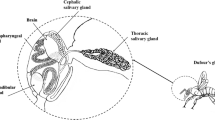Abstract
Hydrocarbons of worker honeybees of known pedigree were extracted and analyzed using gas chromatography and mass spectrometry. Variability in hydrocarbon extracts of individual workers is determined at least in part genetically. Correlations in hydrocarbon composition of extracts were highest among more closely related individuals. Individuals maintained in groups exchange hydrocarbons but still maintain enough self-produced compounds to retain genetically determined individual characteristics. These results demonstrate that extractable hydrocarbons of bees provide sufficiently reliable genetic information to function as labels for use during kin recognition.
Similar content being viewed by others
References
Blomquist, G.J., Chu, A.J., andRamaley, S. 1980a. Biosynthesis of wax in the honeybee,Apis mellifera L.Insect Biochem. 10:313–321.
Blomquist, G.J., Howard, R.W., McDaniel, C.A., andRamaley, S. 1980b. Application of methoxymercuration-demecuration followed by mass spectrometry as a convenient microanalytical technique for double-bond location in insect-derived alkenes,J. Chem. Ecol. 6:257–269.
Breed, M.D. 1981. Individual recognition and learning of queen odors by worker honeybees.Proc. Natl. Acad. Sci. U.S.A. 78:2635–2637.
Breed, M.D. 1983. Nestmate recognition in honey bees.Anim. Behav. 31:86–91.
Breed, M.D., andBennett, B. 1987. Kin recognition in highly eusocial insects, pp. 243–285,in D.J.C. Fletcher and C.D. Michener (eds.). Kin Recognition in Animals, John Wiley & Sons, Chichester.
Breed, M.D., Butler, L., andStiller, T.M. 1985. Learning and genetic influences in the discrimination of colony members by social Hymenoptera.Proc. Natl. Acad. Sci. U.S.A. 82:3058–3061.
Breed, M.D., Stiller, T.M., andMoor, M.J. 1988a. The ontogeny of kin discrimination cues in the honey bee,Apis mellifera. Behav. Genet. 18:439–448.
Breed, M.D., Williams, K.R., andFewell, J.H. 1988b. Comb wax mediates the acquisition of nest-mate recognition cues in honey bees.Proc. Natl. Acad. Sci. U.S.A. 85:8766–8769.
Carlson, D.A. 1988. Africanized and European honey-bee drones and comb waxes: Analysis of hydrocarbon components for identification, pp. 264–274,in G.R. Needham, R.E. Page, M. Delfinado-Baker, and C.E. Bowman (eds.). Africanized Honey Bees and Bee Mites. Ellis Horwood Ltd., Chichester.
Carlson, D.A., andBolton, A.B. 1984. Identification of Africanized and European honey bees using extracted hydrocarbons.Bull. Entomol. Soc. Am. 30:32–35.
Clement, J.-L., Bonavita-Cougourdan, A., andLange, C. 1987. Nestmate recognition and cuticular hydrocarbons inCamponotus vagus Scop, pp. 473–474,in J. Eder and H. Rembold, (eds.). Chemistry and Biology of Social Insects. Verlag J. Peperny, Munich.
Darwin, C.R. 1859. On the Origin of Species by Means of Natural Selection, or the Preservation of Favored Races in the Struggle for Life. 1962. Collier Books Edition (6th ed.). Macmillan, New York. 512 pp.
Errard, C., andFallon, J.-M. 1987. An investigation of the development of the chemical factors in ants' intra-society recognition, p. 478,in J. Eder and H. Rembold (eds.). Chemistry and Biology of Social Insects. Verlag J. Peperny, Munich.
Francis, B.R., Blanton, W.E., andNunamaker, R.A. 1985. Extractable surface hydrocarbons of workers and drones of the genus.Apis. J. Apic. Res. 24:13–26.
Francis, B.R., Blanton, W.E., Littlefield, J.L., andNunamaker, R.A. 1989. Hydrocarbons of the cuticle and hemolymph of the adult honey bee (Hymenoptera: Apidae).Ann. Entomol. Soc. Am. 82:486–494.
Free, J.B. 1987. Pheromones of Social Bees. Chapman and Hall, London.
Gamboa, G.J., Reeve, H.K., andPfennig, D.W. 1986. The evolution and ontogeny of nestmate recognition in social wasps.Annu. Rev. Entomol. 31:431–454.
Getz, W.M. 1991. The honey bee as a model kin recognition system,in P.G. Hepper (ed.). Kin Recognition. Cambridge University Press, Cambridge. In press.
Getz, W.M., andSmith, K.B. 1983. Genetic kin recognition: Honey bees discriminate between full and half sisters.Nature 302:147–148.
Getz, W.M., andSmith, K.B. 1986. Honey bee kin recognition: Learning self and nestmate phenotypes.Anim. Behav. 34:1617–1626.
Getz, W.M., andSmith, K.B. 1987. Olfactory sensitivity and discrimination of mixtures in the honeybeeApis mellifera.J. Comp. Physiol. A 160:239–245.
Getz, W.M., Brückner, D., andSmith, K.B. 1988. Variability of chemosensory stimuli within honeybee (Apis mellifera) colonies: Differential conditioning assay for discrimination cues.J. Chem. Ecol. 14:253–264.
Getz, W.M., Brückner, D., andSmith, K.B. 1989. Ontogeny of chemosensory cues in worker honey beesApis mellifera.Apidologie 20:105–113.
Hamilton, W.D. 1964a. The genetical evolution of social behavior I.J. Theor. Biol. 7:1–16.
Hamilton, W.D. 1964b. The genetical evolution of social behavior II.J. Theor. Biol. 7:17–52.
Laidlaw, H.H. 1977. Instrumental Insemination of Honey Bee Queens. Dadant and Sons, Hamilton, Illinois. 144 pp.
Mintzer, A. 1989. Incompatibility between colonies of acacia-ants: Genetic models and experimental results, pp. 163–182,in M.D. Breed and R.E. Page (eds.). The Genetics of Social Evolution. Westview Press, Boulder, Colorado.
Morel, L., andVan der Meer, R.K. 1987. Nestmate recognition inCamponotus floridanus: Behavioral and chemical evidence for the role of age and social experience, pp. 471–472,in J. Eder and H. Rembold (eds.). Chemistry and Biology of Social Insects. Verlag J. Peperny, Munich.
Page, R.E. 1986. Sperm utilization in social insects.Annu. Rev. Entomol. 31:297–320.
Page, R.E., andBreed, M.D. 1987. Kin recognition in social bees.Trends Ecol. Evol. 9:272–275.
Page, R.E., andLaidlaw, H.H. 1988. Full sisters and super sisters: A terminological paradigm.Anim. Behav. 36:944–945.
Pamilo, P., andCrozier, R.H. 1982. Measuring genetic relatedness in natural populations: Methodology.Theor. Popul. Biol. 21:171–193.
Smith, R.-K. 1988. Identification of Africanization in honey bees based on extracted hydrocarbons assay, pp. 275–280,in G.R. Needham, R.E. Page, M. Delfinado-Baker, and C.E. Bowman, (eds.). Africanized Honey Bees and Bee Mites, Ellis Horwood Ltd., Chichester.
Sneath, P.H.A., andSokal, R.R. 1973. Numerical Taxonomy. W.H. Freeman, San Francisco. pp. 137–140, 190–192.
Sokal, R.R., andRohlf, F.J. 1981. Biometry. W.H. Freeman, San Francisco, pp. 449–450.
Tucker, K.W. 1986. Visible mutants, pp. 57–87,in T.E. Rinderer (ed.). Bee Genetics and Breeding. Academic Press, Orlando, Florida.
Vander Meer, Robert K., Saliwanchik, D. andLavine, B. 1989. Temporal changes in colony cuticular hydrocarbon patterns ofSolenopsis invicta:: implications for nestmate recognition.J. Chem. Ecol. 15:2115–2125.
Author information
Authors and Affiliations
Rights and permissions
About this article
Cite this article
Page, R.E., Metcalf, R.A., Metcalf, R.L. et al. Extractable hydrocarbons and kin recognition in honeybee (Apis mellifera L.). J Chem Ecol 17, 745–756 (1991). https://doi.org/10.1007/BF00994197
Received:
Accepted:
Issue Date:
DOI: https://doi.org/10.1007/BF00994197




